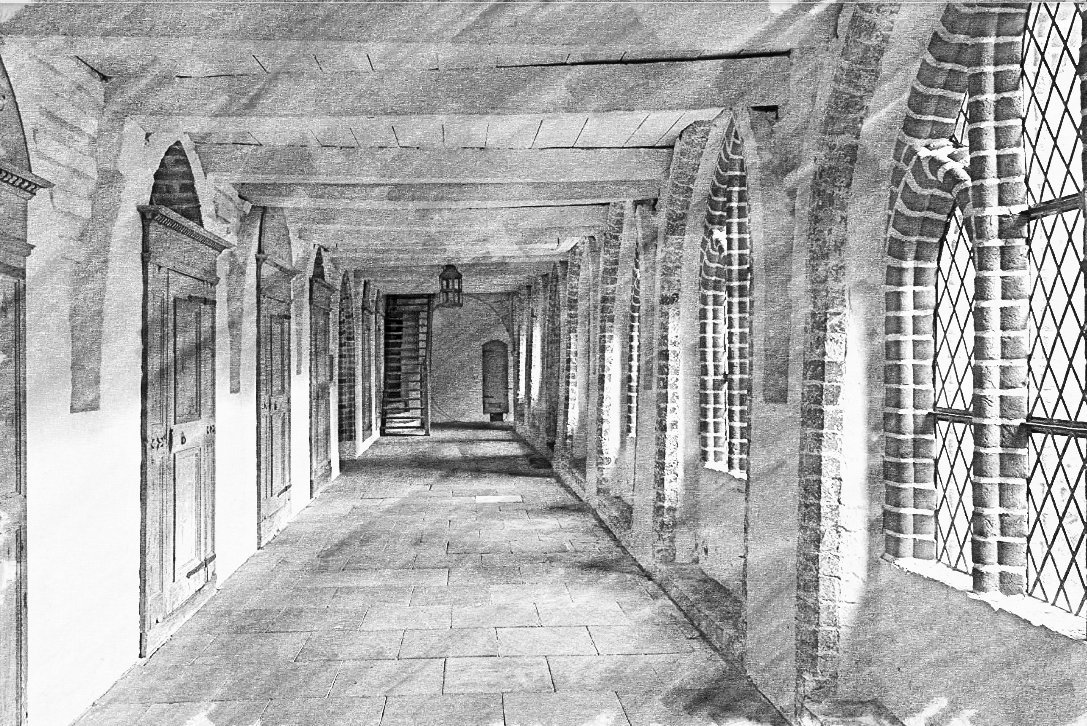Welcome to Rumbeck Monastery
The floor plan shows the buildings of the Premonstratensian monastery after its dissolution in 1804. Based on original drawings and documents, a detailed map from 1827 was reconstructed in 1985. From this, the buildings of the cloister area, the extensive economic facilities and the layout of the ponds can be clearly seen.
On Christmas Day 1121, Norbert of Xanten founded a new community in the French town of Premontré, which is called the Premonstratensian Order after the place where it was founded. The male members (mostly ordained priests) took a vow according to the rule of St. Augustine. Women also joined the community early on and so-called double monasteries were established, in which men and women lived together in different houses. Due to suspicions, the order's leadership in Premontré felt compelled to dissolve such double monasteries as early as 1142. As a result, the women's monasteries settled in separate locations in the vicinity of a men's monastery. This was also the case here in Rumbeck. After Count Heinrich I had donated his main farm Rumbeck to the Wedinghausen monastery he had founded on the occasion of his resignation in 1185, the Arnsberg canons immediately used it to found a women's monastery.
The unique space of this old collegiate church with its squat, narrow and yet high side aisles still exudes the special spirituality of the Premonstratensian nuns who worked here. The church, dedicated to St. Nicholas, once formed the northern end of a two-storey building block with an inner courtyard as a burial site. Together with the provost's house and guest house to the north of the church, the extensive farmyard and the gardens surrounded by the old monastery wall, the structure of this impressive complex can still be clearly seen today - despite some of the buildings being missing.
The park, surrounded by a low wall, patio served as a burial place for the choir nuns. A stone cross still stands in the middle of the square. It commemorates the last prioress buried here, Maria Peters.
After the collegiate church had been rebuilt and renovated in the Baroque style under the provosts Friedrich Bigeleben (1690-1698) and Eberhard Cöbinghof (1698-1714), provost Adam Nackhoff (1714-1745) began to renovate all the monastery buildings immediately after taking office. First, in 1715/16, he had the 1519 church renovated. South wing Here were the Clothing and workshop building with school and probably the chapter house and the prioress’s apartment After the monastery was closed, the first chaplain of the new branch parish lived in an apartment in the south wing. The entire building, together with the granary (east wing), burned down to its foundations in 1914. It was rebuilt shortened by adding three window axes and the previously adjacent east wing. Today the building is used as a parish and community center.
PARAMENT EMBROIDERY OF THE RUMBECK CHOIR WOMEN
The sisters of the Rumbeck monastery were particularly distinguished by their high level of skills in textile handicrafts. They not only made these in the monastery's own workshop, but also taught so-called boarders the art of sewing and embroidery. All novices had to bring a spinning wheel and embroidery kit with them when they were admitted to the monastery. The essential basic materials were produced in the monastery itself. As a result, a linen bleaching and yarn production facility had already developed in the 15th century.
The vestments produced in the Premonstratensian monastery of Rumbeck were initially used for their own needs. During the heyday at the beginning of the 18th century, however, vestments and valuable ornaments were also delivered to surrounding monasteries and churches (including the so-called "Red Chapel" for Wedinghausen Monastery), which were made according to numerous models and ornamental engravings.
A special treasure are six antependia (altar hangings) that covered the front of the mensa according to the times and festivals of the church year. The green antependium in particular (dated ANNO 1728) shows an extremely rich decoration with flowers and tendrils that are grouped around the "Lamb of God" in the center. It is a work with colored silk and metal embroidery, silk fringes and sequins on green silk damask.
The textile handicrafts also include the artistically designed reliquary boxes, which are spread throughout the church and are particularly high quality in the altars. The box with relics of St. Francis of Rome hanging on the north wall near the altar of Mary reveals a secret and shows a Premonstratensian nun in the habit that was probably worn by the Rumbeck choir nuns.

















